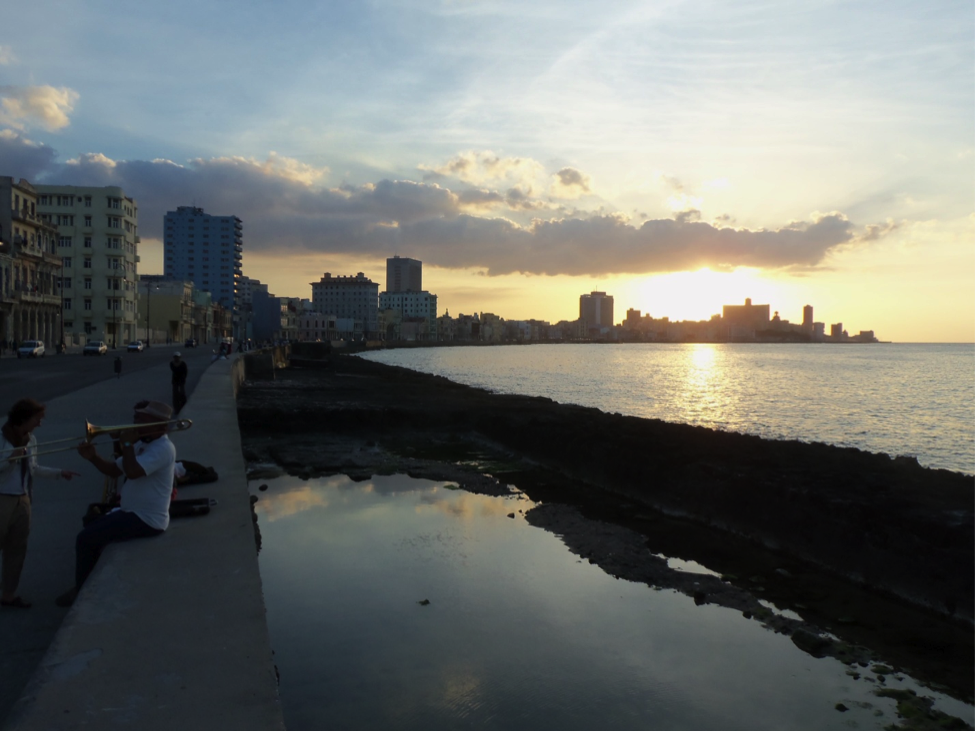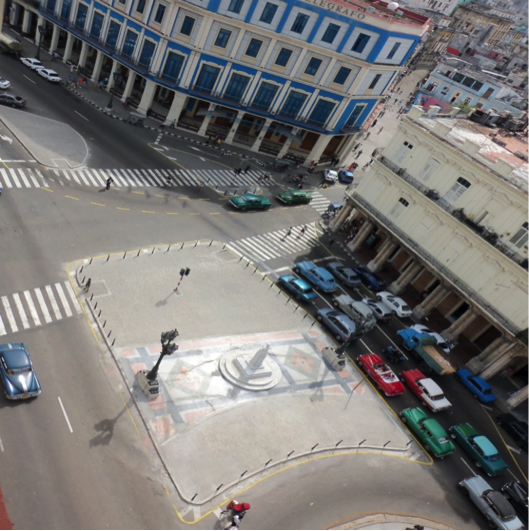US Health Researchers Look to Cuba for Better Outcomes
Resource type: News

By Joseph Vargas
For many Americans, Cuba is perceived as a forbidden island associated with Soviet era revolutionary leaders mixed with distant memories of cold war politics that culminated in the Cuban missile crises of the 1960’s. Although the country maintains its Communist ideology, Cuba has evolved from a bourgeois playground in the 1950’s to a vibrant and emerging developing Caribbean nation that has some of the region’s best health and disaster programs.
Eleven health care professionals were selected to be part of a research team to examine Cuba’s distinguished public health and advanced emergency disaster infrastructure. For most of the teams researchers, including HCA Health Promotion Division’s Joe Vargas, it was their second Cuban visit since their initial research visit in 2010. The 2-week research study was composed of a variety of health care individuals including emergency physician assistants, nurses, a pharmacist, a research scientist, public health officials, a firefighter, paramedics, and a medical equipment designer.
The trip was arranged through MEDICC, an Oakland-based non-profit organization that works to enhance cooperation among the Unites States, Cuban and global health communities to understand and learn how to foster better health outcomes. They also served as the groups official academic advisors throughout the visit arranging meetings with Cuban officials at Hospitals, Clinics, Public Health Ministry, Red Cross, National Ambulance Service, Meteorological Institute, schools and community organizations.
Since the United States has not had diplomatic relations with Cuba and an embargo since the 1960’s, travel to Cuba is restricted to select permitted individuals. Fortunately, this group was allowed special permission visas under the US Treasury Department general license for professional research that includes full-time health related professionals conducting research in Cuba.
Polyclinics: Cuba’s answer to community health
The research group followed a Cuban government approved itinerary that was rigorous and nonstop, covering three main cities on the island nation; Habana, Santa Clara, and Cienfuegos. The trip initiated with field visits to Havana’s unique and efficient public health clinics termed Polyclinics. The strategically placed clinics serve as a hub for the neighborhood that include a doctor/nurse team that live in the community and an accredited research and teaching center for medical, nursing and allied health science students. In addition to providing primary care at their office, the doctor/nurse team make visits to the homes of their patients to conduct health audits and home care visits. Secondary care is provided at the Polyclinic facility where there are specialists that include lab, x-ray, physical and occupational therapy, dental, acupuncture and other services not offered in the neighborhood medical office. Tertiary care is provided at larger hospitals in larger cities, like Havana, where surgery and other more specialized treatments are conducted including transplants.
 The polyclinics are responsible for about 80- 130 families in their catchment area. One unique requirement is that Polyclinics are required to continually monitor and routinely conduct a health assessment of the neighborhood population they are responsible for and transform the service offered by the clinic, based on these needs. As it was explained to the US researchers, if the data or health picture of the community indicates that there is an increase in a health issue like smoking, then services like cessation counseling sessions would be increased a few days a week. Likewise, if there is an increase in a communicable disease in the community, then extra campaigns, monitoring and education would be directed expeditiously within the community to deter further cases. Polyclinic officials commented that because of their lack of financial ability to purchase costly medical equipment and supplies, Cuba medical personnel rely intensely on primary prevention efforts because they understand this to be the most cost-effective alternative to prevent future medical complications. A quick look at Cuba’s health indicators are a reflection of the strong preventive primary-care structure enacted for the last 40 years. Many of these numbers surpass or are equal to industrialized countries in the world. According to WHO, Cuba has one of the world’s highest life expectancies at 77 years (WHO, 2008).
The polyclinics are responsible for about 80- 130 families in their catchment area. One unique requirement is that Polyclinics are required to continually monitor and routinely conduct a health assessment of the neighborhood population they are responsible for and transform the service offered by the clinic, based on these needs. As it was explained to the US researchers, if the data or health picture of the community indicates that there is an increase in a health issue like smoking, then services like cessation counseling sessions would be increased a few days a week. Likewise, if there is an increase in a communicable disease in the community, then extra campaigns, monitoring and education would be directed expeditiously within the community to deter further cases. Polyclinic officials commented that because of their lack of financial ability to purchase costly medical equipment and supplies, Cuba medical personnel rely intensely on primary prevention efforts because they understand this to be the most cost-effective alternative to prevent future medical complications. A quick look at Cuba’s health indicators are a reflection of the strong preventive primary-care structure enacted for the last 40 years. Many of these numbers surpass or are equal to industrialized countries in the world. According to WHO, Cuba has one of the world’s highest life expectancies at 77 years (WHO, 2008).
Public Health’s Neighborhood Participatory Model
The research team was fortunate to be able to visit the National School of Public Health and talk with Cuban medical professionals about the Cuban Public Health system and their vast disaster experiences working in austere environments. Cuba has a history of sending large numbers of medical teams internationally that are affected by disasters including recent missions to Pakistan, Haiti, Chile, Peru and Indonesia. The two countries were able to exchange viewpoints of best practices in managing medical care and disaster preparedness to vulnerable populations. Both international teams agreed that preparedness must be viewed and embraced by the local people as a community wide effort, ensuring that everyone works collaboratively due to limited availability of health and emergency services during disasters. The US research team expressed particular interest in the success of the community participatory model where every Cuban whether young or old plays an essential role in their community’s health and quality of life. The team was able to see this in practice through their participation in a neighborhood meeting. At the core of these weekly meetings held in front of the elected neighborhood leaders residence is an opportunity for all residents to share any of their community concerns. Most importantly any residential issue from concerns of senior transportation to unsafe street lighting can be identified by any resident young or old and resolved through the neighborhood leader process.

Universal Health Care: A Cuban Right
A prominent yet important lesson researchers had to comprehend was the repeated reference to universal health and the Cuban Constitution throughout the visit. This is in reference to article 50 of the Cuban Constitution that stipulates that all Cubans are entitled to receive free medical care and to have their health protected. It also details the government to provide medical and hospital care free of charge, including dental care, prophylactic services and access to specialized centers. Other key and impressive components of the Constitution embrace preventive care, specifying that the State shall develop plans for health education, programs for periodic medical examinations, immunization and other preventive measures.
International Conference
The research team was also invited to attend the 2nd Annual Health and Disaster Conference in Habana, Cuba. The international conference consisted of workshops in mental health, risk-communication, international cooperation, communicable diseases and vulnerable populations. Workshop presenters included experts from Ecuador, Argentina, Chile, Mexico and Great Britain. As invited guest, the US delegation was invited to provide an impromptu presentation related to US disasters. The conference provided a unique opportunity for the US researchers to share earthquake preparedness plans for California’s high-risk fault areas. Conference attendees were captivated once they were introduced to the risk-reduction models and emergency procedures that the team has experience with. Most of the US team are also members of Disaster Medical Assistant Teams(D-MAT) in California and have responded to numerous national and international disasters. Several foreign press were present including Radio Habana and Cuban television to interview team members and spotlight the research visit and the findings of the US group.
Early Disaster Training in Schools
One of the most memorable visits was to Orlando Pantoja elementary school outside of Havana. Upon the arrival of the team the whole student body participated in a welcoming friendship song waving their uniform scarves from the balconies of the three story school building. To show their enthusiastic understanding of their disaster training, students from 3rd grade gave an impressive demonstration of first aid skills that included applying splints, neck collars and CPR. Faculty were equally proud to demonstrate that the lesson plans include emergency and disaster preparedness as early as the first grade due to Cuba’s geographical exposure to numerous tropical storms. Random conversations and interviews with children throughout Cuba confirmed the children’s thorough command of these critical preparedness skills and knowledge. The group learned that this early institutionalization of disaster preparedness is extremely effective and reflected in data that indicates smaller numbers of fatalities related to major tropical storms in Cuba compared to other industrial countries with more financial resources.
To finalize the research visit, the group toured several medical facilities including a hospital, ambulance headquarters, emergency dispatch facilities, Red Cross, and meteorological institute. At these facilities, the research team was able to get an inside account of Cuba’s robust primary prevention focused medical system and understand it’s critical ties to civil defense teams, meteorological and information sharing systems.
After their return to the US, the research team is currently processing information for submission to academic journals for publication and scheduling presentations to share their experiences in Cuba to interested organizations.
World Health Organization,The World Health Report 2008: Primary Health Care Now More Than Ever. Geneva, 2008.
MEDICC is an Atlantic grantee.
